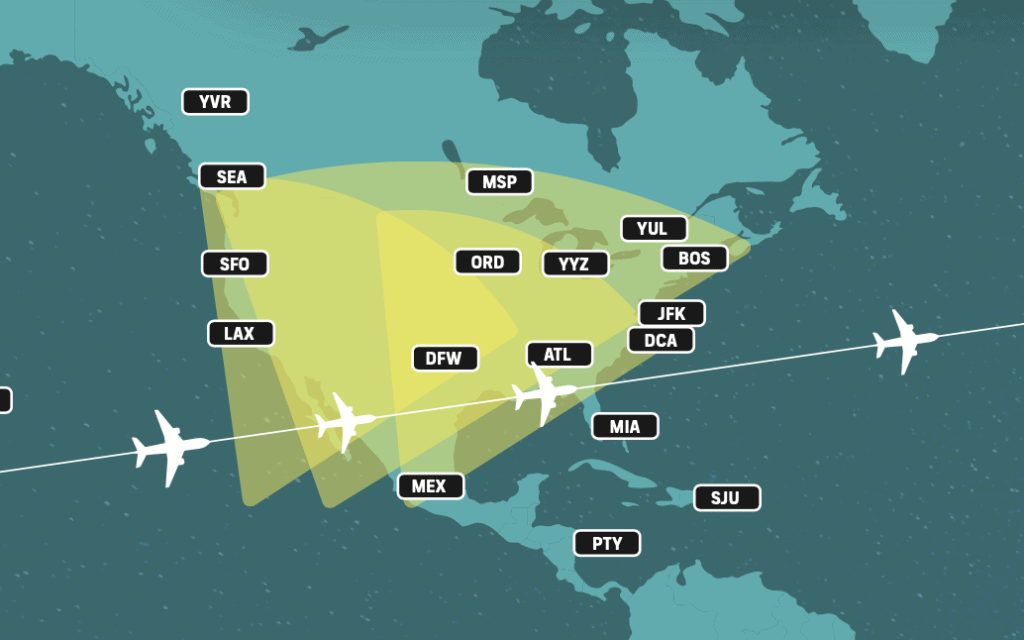Inmarsat and Hughes Promise Unrivalled In-Flight Wi-Fi With GX+ North America
Share

Inmarsat and Hughes Network Systems have unveiled a major strategic collaboration for North America, integrating Inmarsat’s Global Xpress (GX) with Hughes’ JUPITER™ high-throughput satellite (HTS), bringing higher capacity, speed and reliability to the region. Inmarsat will provide and manage the new GX+ North America solution end-to-end. Prototype flights are planned for later this year, with commercial availability scheduled for 2021.
GX+ North America, a service from Inmarsat and Hughes, promises to offer North American airlines and their customers high-speed, reliable and stable coverage for in-flight broadband, even when flying at full capacity over the busiest airport hubs. Airlines will also have greater flexibility for route planning and fleet usage, even on short notice.
The solution can cover any route worldwide through the GX global network — including flights to Hawaii, Canada, Bermuda, the Caribbean, across the Gulf of Mexico, to Central and South America, across the Atlantic and even to the most extreme northern latitudes. It utilizes a Thinkom Ka-band flat panel antenna with smart dual aero modem technology powered by Inmarsat’s aviation solutions.
“We have been working on this for some time, so it was in the planning stages [when the pandemic happened],” Niels Steenstrup, SVP of In-Flight Business & Americas Market Capture at Inmarsat Aviation, told APEX Media. Despite the impact of the pandemic, he added, North American airlines are actively looking for solutions that will ensure they can offer stable connectivity going forward. “They’re thinking about what the passenger experience is going to look like and what they want to do in the future.” Current changes in the marketplace have also caused some airlines to review their service provider contracts to ensure that they can support their long-term needs, he said.
Even as airlines review their fleets and routes, adjusting to lower demand, those traveling still expect to be connected. “We are seeing increased use of connectivity among those that are traveling,” Steenstrup said.
Steenstrup also believes that connectivity-enabled passenger experience services will enhance airline service value during and after the pandemic. “Things like in-flight entertainment, contactless payment, and contactless catering improve passenger confidence,” he said.
Steenstrup also shared some connected passenger services that might become increasingly important as we go through and come out of this pandemic. “We’ll be reducing the number of touchpoints: ordering drinks from your seat without having to interact with a flight attendant; getting in queue for the lavatory based on [an alert from your] smartphone, as opposed to queuing in the aisles; being able to fill out your immigration forms online before you land, and things like that,” he suggested.
“The strong competition between the big carriers in North America means that they are looking for a very strong, reliable solution for the future.” – Niels Steenstrup, Inmarsat Aviation
The ultra-high capacity of GX+ North America will allow North American airlines to meet increasing passenger demand, including the surge in traffic expected from free-of-charge in-flight Wi-Fi. Steenstrup said reliable, free connectivity services will continue to rise in popularity both with passengers and airlines and will remain a brand differentiator.
“Some airlines were already talking about giving a free service to all their passengers, all the time,” he said. “That’s very well received and does differentiate the experience. It has or may have enabled airlines to take market share from one another by having a highly functional solution that just works reliably. The strong competition between the big carriers in North America means that they are looking for a very strong, reliable solution for the future.”
Inmarsat and Hughes will continue to anticipate the North American market’s evolving needs, expanding the service to meet demand. Over the next four years, the Hughes and Inmarsat combined constellation of seven GX and JUPITER satellites will more than double to a total of 15 spacecraft. These additional satellites include the Hughes ultra-high capacity JUPITER 3 satellite and Inmarsat’s seven next-generation GX satellite payloads (6A, 6B, 7, 8, 9, 10A and 10B), which will enhance capacity and coverage throughout the world, including the Arctic.


